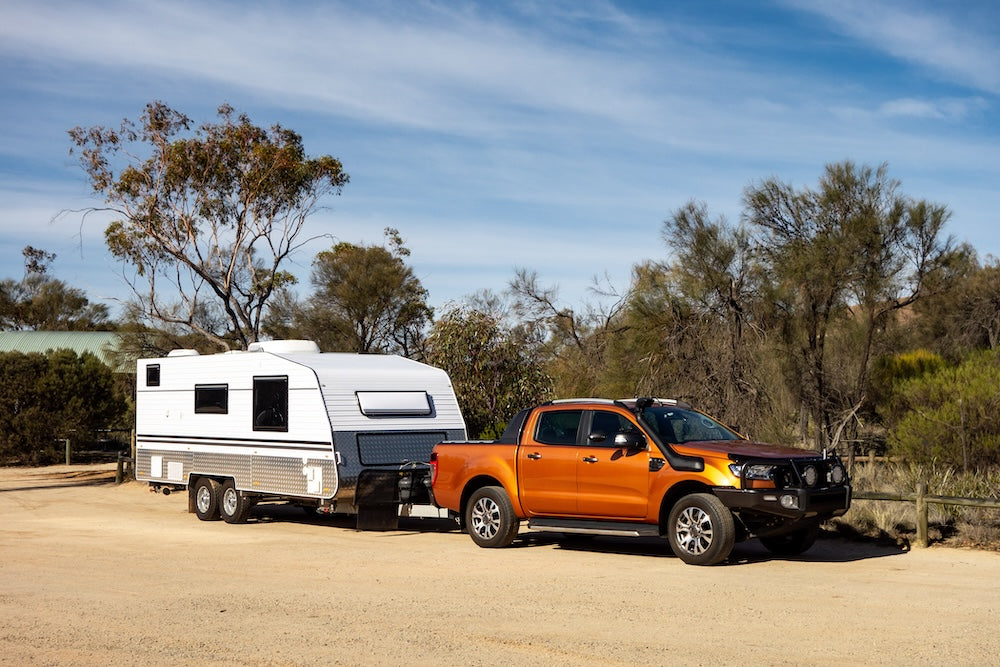Let’s face it, travel trailers have more than their share of towing challenges. From stiff crosswinds and cargo movement to trailer sway, many factors can change an easy drive into an anxiety-ridden journey. Whether you’re an experienced driver or new to towing, we’ve got something to keep you safe and trouble-free on the road. Here are the top tips for towing a travel trailer.
Know Your Vehicle and Trailer
Your towing system has to be compatible and set you up for success. Knowing the towing capacity of your weakest link is essential to ensure it’s strong enough to safely tow your travel trailer. This means understanding key specs such as the gross vehicle weight rating (GVWR), tongue weight, trailer height, and weight distribution.
You want all this to be set before you leave the driveway - don’t experiment with it on your first long trip or you’re inviting common issues with braking, trailer swaying, and bounce. Likewise, keep all key components in good working condition so you can trust everything to perform away from home. Specifically, pay close attention to your tires, hitch ball, and brake controller.
Preparation
It might feel like overkill, but a physical or digital checklist makes it nearly impossible to overlook small details that can derail a trip. Eventually, the checklist becomes second nature and provides a consistent process and peace of mind.
You’ll want to physically check the tow vehicle and trailer to make sure all brake lights, turn signals, trailer brakes, and physical connections are working. The interior of the travel trailer is easy to forget so a checklist detailing what to secure inside is invaluable. Travel trailers vary greatly in amenities and storage and this promises everything to arrive in the same condition as when you left.
Developing an emergency kit specific to your trailer is essential. This can be as simple or elaborate as you’d like, but at a minimum keep easy to replace parts, applicable tools, first aid supplies, and roadside safety gear. Store this in the trailer and always double-check it’s there. Most importantly, don’t allow yourself or others to “borrow” from it at home since the odds are high it won’t be replenished.
Plan Your Route
Knowing both specific and alternate routes is a big advantage, especially on long trips. You want to keep your travel trailer in places where it’s easy to maneuver. Hopefully, you’re not stopping and going constantly. Knowing your gas mileage is helpful so you can plan on where to fuel up as well. Never push the limits on gas since you’ll inevitably end up in a tiny gas station with no room to turn or park. Instead, plan accordingly so you can stop at stations with easy access and plenty of space.
Practice
Of all the tips for towing a travel trailer, this one hits our ego like no other - you need to practice. If you’ve never pulled a travel trailer or just want to sharpen your skills, there’s no shame in going to an empty parking lot. Towing a travel trailer is a perishable skill, so it’s advantageous to practice backing up, turning, or testing out new equipment in a safe, traffic-free environment.
Tight turns are notoriously difficult or impossible. When it comes to turning, understand that the longer the trailer, the wider the turning radius. You can also get up to speed on a highway close to home to see how it handles at different speeds. Best of all, you can get a feel for the stopping distance at various speeds.
Weather Considerations
There’s nothing like white-knuckling the steering wheel to start out a vacation. Until you tow a trailer through a 40 MPH crosswind or in heavy precipitation, it’s difficult to understand how it changes the drive. A travel trailer is essentially a big sail behind your tow vehicle and you’ll be at a huge advantage if you can experience this on a test drive first. This circles back to practicing, but knowing firsthand how the trailer pulls in wind is a lot less nerve-wracking close to home. If possible, understanding both headwinds and crosswinds is ideal.
Since we can’t control the weather, always remember that you’re more likely to be delayed due to unforeseen circumstances. And instead of pushing through, know that it does us no good if we don’t make it to the destination because we push the limits beyond our driving skills. Always check the forecast before you leave and adjust accordingly. Additionally, know the weather tendencies in the areas you’ll be traveling through.
Driving
Road etiquette is critical when driving a travel trailer. As the miles tick on and you become accustomed to the drive, never forget that it isn’t a passenger car. You’re pulling a lot more both behind your vehicle and above. Be aware of bridges, drive-thrus, and the impact of other vehicles as they drive alongside. Driving defensively is essential as movements take longer to complete. Always pass with caution, adapt and evaluate when conditions change, and never be too proud to exit and stop if necessary.
We’ve saved the most important for last. Slow down - just because the speed limit is 75 MPH doesn’t mean you need to go that fast. In fact, you’ll find a lot of experienced travel trailer owners who recommend a maximum speed of 65 miles per hour under ideal conditions. Lower speeds offer much safer driving conditions and better fuel mileage. And after all, slowing down and taking time to get away is the whole point of the adventure.

